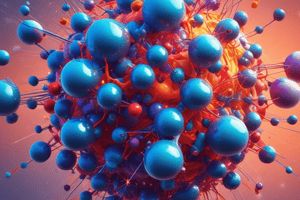Podcast
Questions and Answers
What is required for a successful chemical reaction according to collision theory?
What is required for a successful chemical reaction according to collision theory?
- Collisions must have energy greater than or equal to the activation energy. (correct)
- Particles must collide with a surface.
- Molecules must be of the same orientation.
- Particles must collide at any speed.
How does changing the conditions of a reaction affect particle collisions?
How does changing the conditions of a reaction affect particle collisions?
- It alters the activation energy required for the reaction.
- It increases the chances of collisions occurring with sufficient energy. (correct)
- It has no effect on the specific energy of the particles.
- It decreases the likelihood of collisions occurring.
What does the area under the Maxwell-Boltzmann distribution curve represent?
What does the area under the Maxwell-Boltzmann distribution curve represent?
- The average energy of the molecules.
- The proportion of molecules that will react.
- The number of molecules with energy greater than the activation energy.
- The total number of molecules in the sample. (correct)
What effect does an increase in temperature have on the Maxwell-Boltzmann distribution?
What effect does an increase in temperature have on the Maxwell-Boltzmann distribution?
How do increased molecular speeds due to heating affect reaction rates?
How do increased molecular speeds due to heating affect reaction rates?
What does a greater proportion of molecules having energy greater than or equal to the activation energy indicate?
What does a greater proportion of molecules having energy greater than or equal to the activation energy indicate?
What role does thermal energy play in increasing reaction rates?
What role does thermal energy play in increasing reaction rates?
Why do not all particles in a substance have the same energy?
Why do not all particles in a substance have the same energy?
What happens to the rate of reaction when the concentration of a substance is increased?
What happens to the rate of reaction when the concentration of a substance is increased?
What effect does increasing pressure have on the molecules of a gas?
What effect does increasing pressure have on the molecules of a gas?
What is the primary function of a catalyst in a chemical reaction?
What is the primary function of a catalyst in a chemical reaction?
How does the presence of a catalyst change the Maxwell-Boltzmann distribution curve?
How does the presence of a catalyst change the Maxwell-Boltzmann distribution curve?
What is affected when the activation energy is lowered by a catalyst?
What is affected when the activation energy is lowered by a catalyst?
Flashcards are hidden until you start studying
Study Notes
Collision Theory
- Chemical reactions occur when particles collide.
- For a reaction to be successful, the collisions must have energy greater than or equal to the activation energy, and the particle orientation must be correct.
- Reaction conditions can be altered to provide particles with more energy, increasing the rate of reaction.
Maxwell-Boltzmann Distribution
- Not all molecules in a substance have the same amount of energy.
- The energies of molecules are distributed in a pattern called the Maxwell-Boltzmann distribution.
- Changing reaction conditions alters the shape of the Maxwell-Boltzmann distribution curve.
- The total area under the curve represents the total number of molecules in the sample and must remain constant.
Effect of Temperature
- When a substance is heated, thermal energy is transferred to the substance.
- Thermal energy is converted to kinetic energy, causing the molecules to move faster and further.
- Increased movement of the molecules leads to more frequent and energetic collisions.
- Increasing the reaction temperature increases the rate of reaction.
- The Maxwell-Boltzmann distribution at an increased temperature shifts to the right, so a greater proportion of molecules have energy greater than or equal to the activation energy.
Effect of Concentration and Pressure
- Increasing the concentration of a substance leads to a higher density of molecules in the same volume.
- This increases the likelihood of collisions between molecules, resulting in an increased rate of reaction.
- Increasing pressure has a similar effect as molecules are packed closer together in a smaller volume.
- The Maxwell-Boltzmann distribution is shifted to the right, so a greater proportion of molecules have energy greater than the activation energy.
Effect of Catalysts
- A catalyst is a substance that increases the rate of reaction without being consumed in the process.
- Catalysts provide an alternative reaction pathway with a lower activation energy.
- The shape of the Maxwell-Boltzmann distribution curve remains unchanged, but the position of the activation energy is shifted to the left.
- This allows a greater proportion of molecules to have sufficient energy to react.
Studying That Suits You
Use AI to generate personalized quizzes and flashcards to suit your learning preferences.




